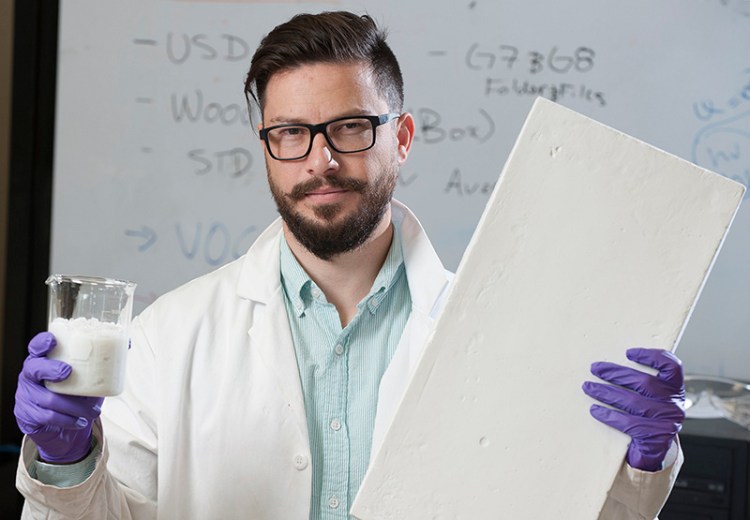Entrepreneur Nadir Yildirim is among those convinced that Maine’s troubled forest products industry is merely going through a period of transition, as innovative minds develop new products that will catalyze a resurgence in demand for the state’s most abundant natural resource.
His stake in this next generation of wood-based products is a foam insulation board made from the molecular building blocks of wood called cellulose nanofibers. The boards made by Yildirim’s high-tech startup, Revolution Research Inc., are 100 percent recyclable, unusual among the other foam insulation boards on the market that are typically made from petroleum-based materials.
“I personally believe these (cellulose) nanofibrils will be the raw material of the future,” said Yildirim, who has a Ph.D. in forest resources from the University of Maine. “It will create a significant change for the future of the Maine forests.”
Yildirim is among those who see new, innovative uses that can come from Maine’s 17 million acres of forest. Those innovations include wood-based biofuels, plastics and chemicals, engineered construction materials that rival the strongest steel, and cellulose nanofiber additives from wood that can boost the durability of products ranging from paper to concrete.
Yildirim, whose company has received several grants from scientific and economic development organizations, is speaking at an upcoming conference on the next generation of wood products that he described as an opportunity for innovators and forest industry leaders to share information about the industry’s future potential with each other and the public.
“We need to show them we can use trees in a better way,” he said. “Instead of making $100 from a tree, you can make $1,000 from a tree.”
A group of industry leaders, researchers, entrepreneurs and academics will meet Saturday in Hiram for the Wood Innovators Conference, organized by Forest Works!, a working-forest conservation partnership, and Tear Cap Workshops, an educational nonprofit based at the Hiram Works business incubator for innovative wood products, located in a former saw mill.
The all-day conference will feature a variety of discussions about current trends in the development of new forest products, with an emphasis on construction materials, biofuels, cellulose nanofibers and policy initiatives to boost the nascent next-gen wood products industry. The conference, from 8:30 a.m. to 4 p.m. Saturday at Hiram Works, is open to the public.
“Innovation is not just about internet startups and new apps for cellphones,” said Lee Burnett, project director at Forest Works! and one of the conference’s organizers. “Some of the most promising job-producing innovation in Maine is happening in the woods, and in niche factories and laboratories.”
The focus on new wood products could revive a flagging industry in Maine and bring jobs back to communities that have been devastated economically by paper mill closures, said scheduled conference speaker Charlotte Mace, executive director of Biobased Maine. In the past two years, five mills have closed, displacing thousands of workers.
Mace said part of the reason she wanted to participate in the conference is that she was raised near Hiram in a community that has suffered because of decreased demand for traditional forest products. She sees the new generation of innovative wood products as a solution to that problem.
“We just want that sector of the industry to grow,” Mace said.
Habib Dagher, director of the Advanced Structures and Composites Center at the University of Maine in Orono, oversees one of the world’s largest laboratories experimenting with nanocellulose composites, engineered lumber and other innovative products. The center operates like a business, with a staff of 180 people and about 500 clients all over the world. More than 95 percent of the center’s funding comes from outside of Maine, from organizations that support the development of high-tech products made from wood.
“It’s our largest natural resource right now,” Dagher said. “We need to come up with next-generation ways to use it.”
Products being developed or tested at the center include panels of “cross-laminated timber,” a construction material that is as strong as concrete and steel but lighter and easier to work with. Dagher said it can be used to construct buildings of 10 stories or higher with frames made entirely of wood.
The center also is working with a variety of composite materials that contain cellulose nanofibers from wood. Dagher said the nanofibers have an unusual ability to add strength to whatever material they are mixed with, including plastics, cement and concrete. The center is using composites to make sheet piling for sea walls that can last 100 years underwater without corroding like steel.
Nanocellulose-based plastics can be used to build any number of molded or even 3-D printed structures that combine the best properties of both plastic and lumber, Dagher said.
“In 20 or maybe 30 years we may be talking about nanomills in Maine,” he said.
Send questions/comments to the editors.




Success. Please wait for the page to reload. If the page does not reload within 5 seconds, please refresh the page.
Enter your email and password to access comments.
Hi, to comment on stories you must . This profile is in addition to your subscription and website login.
Already have a commenting profile? .
Invalid username/password.
Please check your email to confirm and complete your registration.
Only subscribers are eligible to post comments. Please subscribe or login first for digital access. Here’s why.
Use the form below to reset your password. When you've submitted your account email, we will send an email with a reset code.